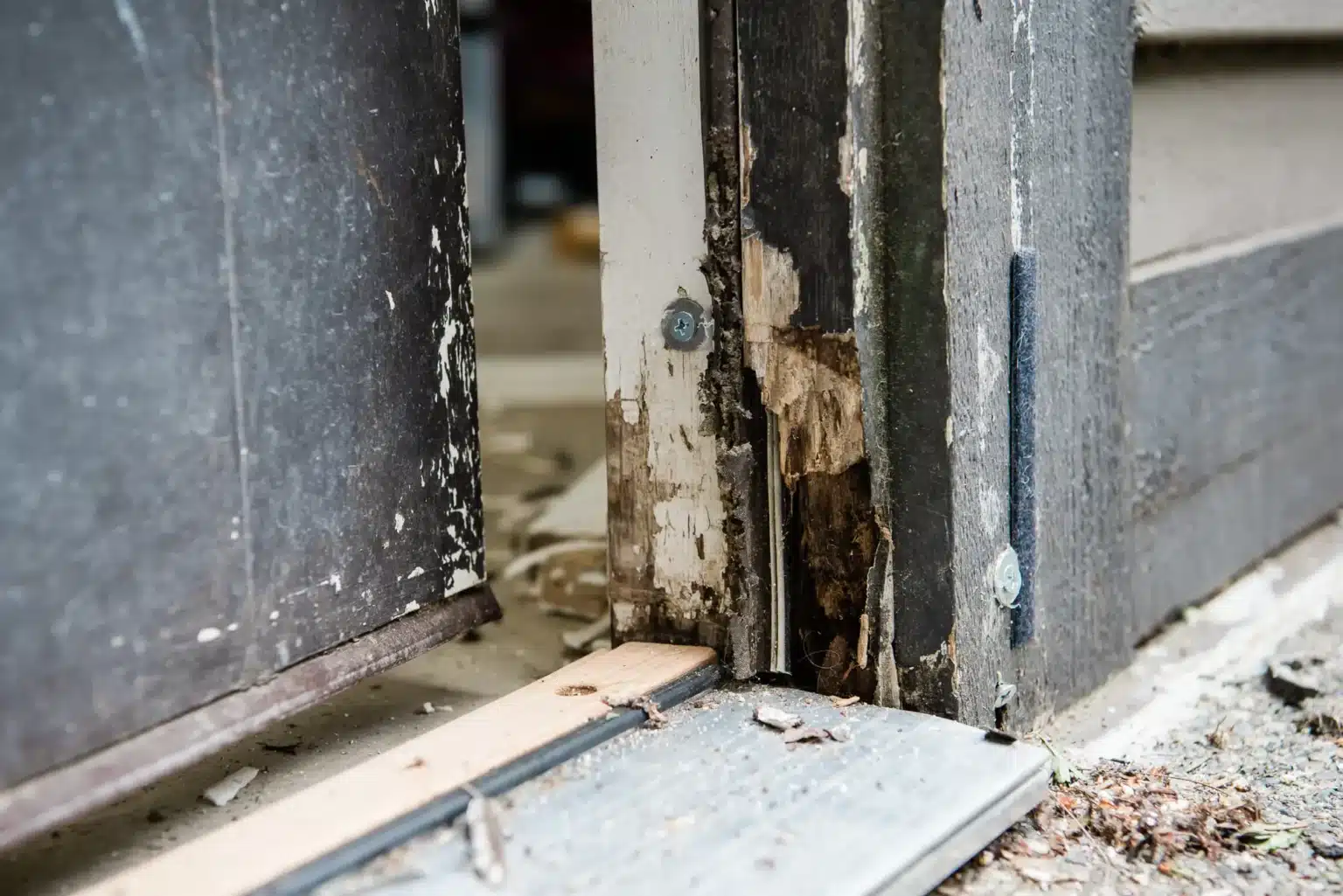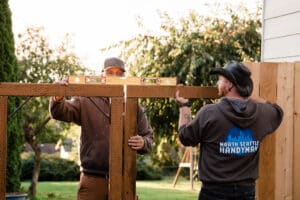Wood Rot—Repair or Mitigate? Learn how to spot signs of wood rot so you can prevent it before it becomes a major repair issue.
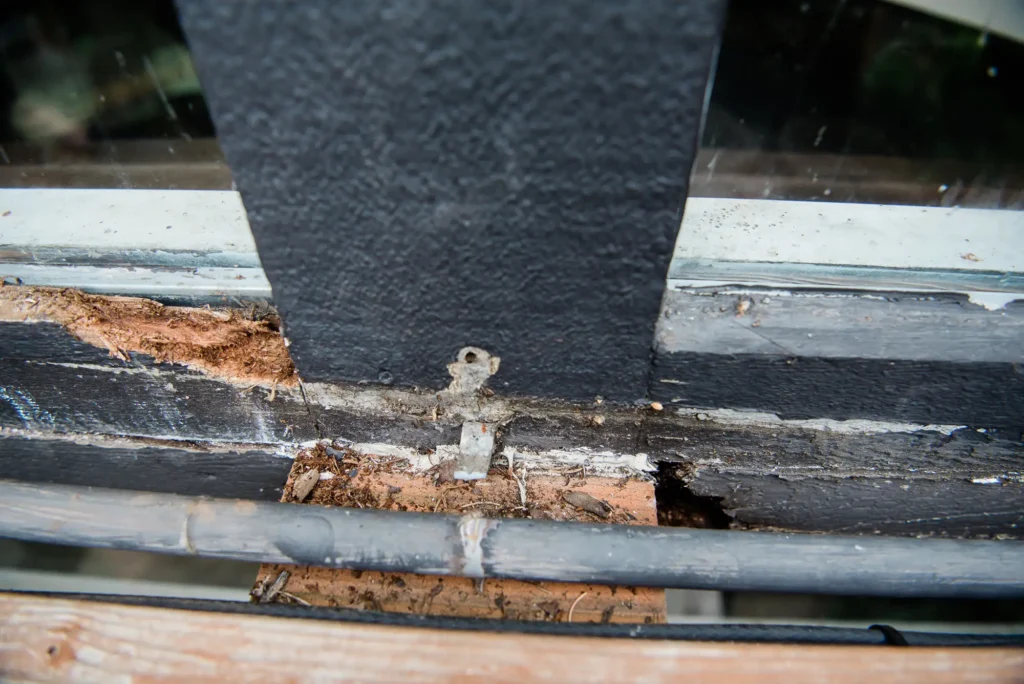
As we head into the rainy season here in the Pacific Northwest, it’s essential to address a common but often overlooked issue: wood rot, also known as dry rot. This sneaky fungus can wreak havoc on your home, but don’t worry—we’ve got you covered with some practical tips on how to spot it and why it’s crucial to deal with it right away.
What Exactly is Wood Rot?
Wood rot, commonly referred to as dry rot, is a type of fungus that thrives in damp wood. Given our area’s rainy climate, dampness is a frequent condition for many months of the year. When wood rot sets in, it can make the wood in your home weak and crumbly, and it tends to spread. It typically appears in areas that remain damp and lack proper ventilation. Since it spreads internally into the structure of your home, catching it early can save you from a massive, expensive repair job.
How to Spot Wood Rot Inside Your Home
Identifying wood rot early can prevent extensive damage. Here are some signs to look for inside your home:
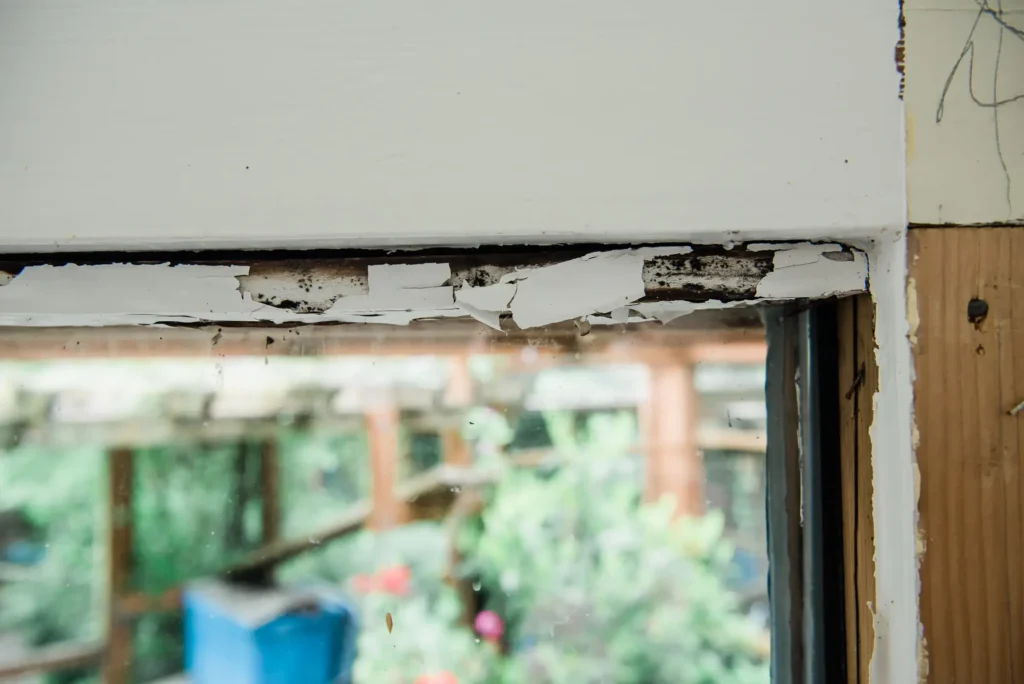
1. Look Around:
- Paint Issues: Check for peeling or discolored paint. This might indicate moisture trapped beneath the surface.
- Wood Discoloration and Cracks: Notice if any wood appears darker than normal or has cracks—these are signs that warrant closer inspection.
- Texture Changes: Look for wood that seems shrunken or has a different texture than surrounding areas.
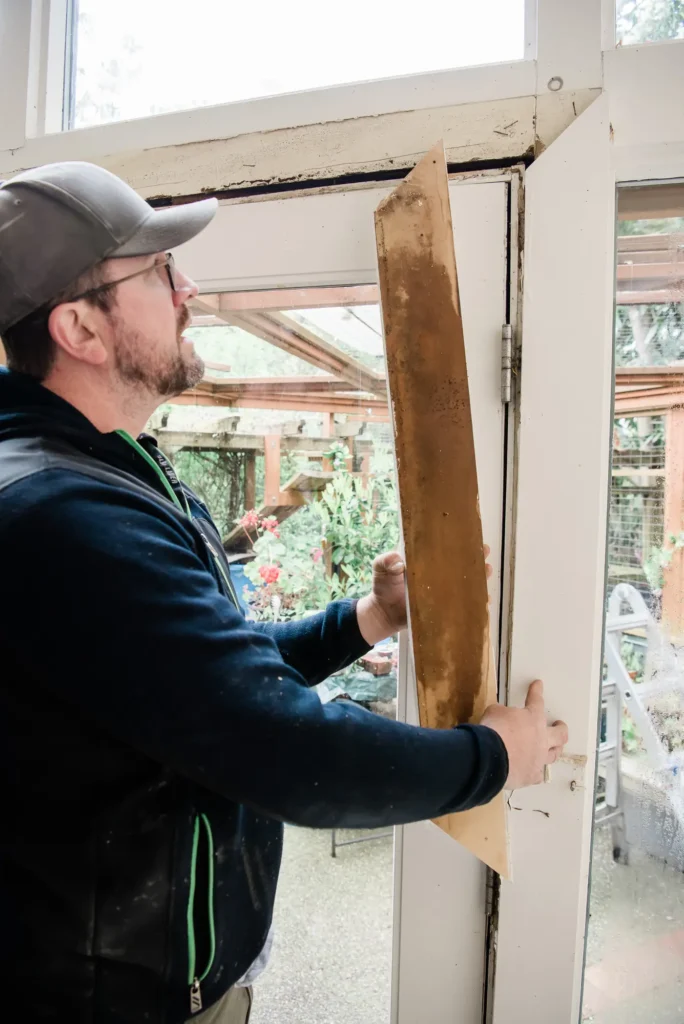
2. Give it a Press:
- Soft Wood: Use a screwdriver or similar tool to press into the wood. If it feels soft or crumbles easily, that’s a red flag.
- Structural Integrity: Poke around window sills, door frames, and baseboards to ensure the wood is still solid.
3. Use Your Nose:
- Musty Odor: A musty, damp smell in certain spots can be a telltale sign of wood rot. Trust your nose—if something smells off, it’s worth investigating.
4. Watch for Warping:
- Deformations: Warped, buckling, or swelling wood should be checked out further, as these deformations can indicate underlying rot.
- Movement: If wood feels loose or moves under slight pressure, it could be compromised by rot.
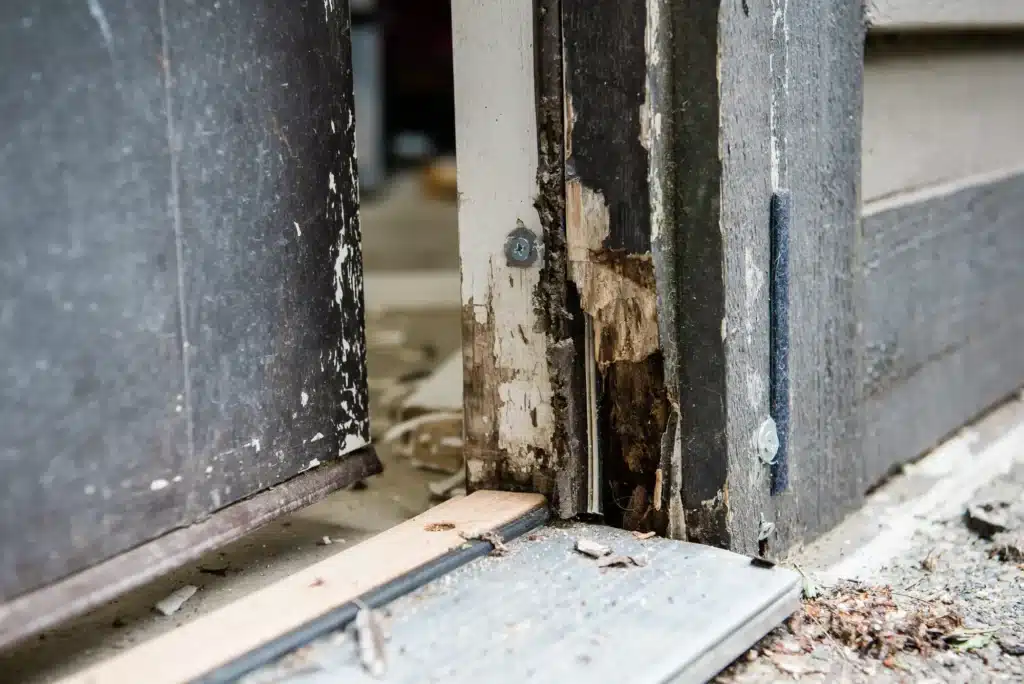
How to Spot Wood Rot on the Exterior of Your Home
Exterior wood rot can be just as damaging as interior rot, so it’s important to keep an eye out for signs outside your home:
1. Inspect Wooden Structures:
- Decks and Porches: Check for any soft spots, discoloration, or areas where the wood appears to be separating.
- Siding and Trim: Look for peeling paint, cracks, or areas that seem swollen or warped.
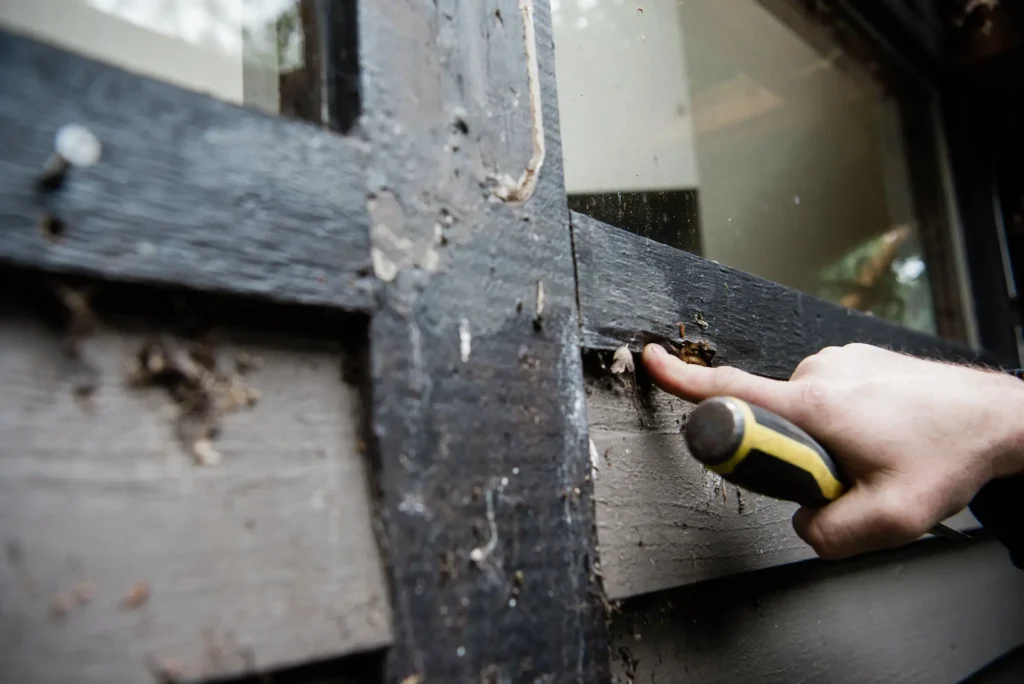
2. Check Around Windows and Doors:
- Frames and Sills: Use a screwdriver to press into the frames and sills around windows and doors. Soft or crumbling wood is a clear indicator of rot.
- Caulking: Look for gaps or cracks in the caulking, which can allow moisture to seep in and cause rot.
3. Examine Roof Eaves and Overhangs:
- Fascia Boards: These areas are prone to rot due to constant exposure to the elements. Look for any signs of discoloration, warping, or crumbling wood.
4. Look at Fences and Gates:
- Posts and Panels: Check the base of fence posts and the bottom edges of panels for any signs of rot. These areas are often in direct contact with the ground and moisture.
Why Should You Care About Wood Rot?
Ignoring wood rot can lead to several serious issues:
1. Keep Your Home Safe:
- Structural Weakness: Wood rot can weaken the structure of your home, posing significant safety hazards and leading to costly repairs. Catching wood rot early might only require replacing a bit of fascia or a couple of boards. However, if left to spread, it could necessitate a major renovation.
- Cost Efficiency: Early intervention can save thousands in potential repairs, turning what could be a major project into a minor fix.
2. Stop the Spread:
- Fungal Spread: The fungus can move to other wooden parts of your house, escalating the problem and increasing repair costs.
- Preventative Measures: Stopping wood rot in its tracks can prevent it from compromising other areas of your home.
3. Breathe Easier:
- Health Concerns: Mold and mildew often accompany wood rot, which can cause health issues such as allergies or asthma, affecting your quality of life.
- Indoor Air Quality: Maintaining good indoor air quality is crucial, especially in homes where family members may have respiratory issues.
What Can You Do About It?
Here are some preventive measures to keep wood rot at bay:
1. Let the Air In:
- Ventilation: Ensure your home is well-ventilated, especially in basements, attics, and crawl spaces. Proper ventilation helps reduce dampness, making it less conducive for wood rot to thrive.
- Air Circulation: Use fans or open windows regularly to promote air circulation in areas prone to moisture.
2. Keep Things Dry:
- Dehumidifiers: Use dehumidifiers in damp areas, fix any leaks quickly, and ensure water drains away from your home’s foundation. Keeping your home dry is key to preventing wood rot.
- Gutter Maintenance: Keep gutters clean and ensure downspouts direct water away from the house to prevent pooling around the foundation.
- Roof and Plumbing Checks: Regularly inspect your roof and plumbing for leaks, and repair them promptly.
3. Check Regularly:
- Routine Inspections: Perform regular inspections, especially before and after the rainy season, to catch any issues early. Regular checks can help you spot potential problems before they escalate.
- Professional Assessments: Consider having a professional inspection annually to ensure no early signs of wood rot are missed.
4. Call in the Pros:
- Expert Help: If you suspect wood rot, it’s best to call in the experts. At North Seattle Handyman, we specialize in wood rot repair, ensuring your home remains safe and sound. Our team can identify and fix wood rot, preventing further damage and saving you money in the long run.
- Quality Assurance: Professional repair ensures the job is done correctly, giving you peace of mind that your home is protected.
By taking proactive steps to prevent wood rot, you can protect your home and avoid costly repairs. Regular inspections, proper ventilation, and quick action on any signs of dampness are crucial. If you need help or have any questions, don’t hesitate to reach out to us at North Seattle Handyman. We’re here to help keep your home in top shape.
Stay dry and take care!
Visit our blog regularly for more information on wood rot repair and other home maintenance tips. We’re committed to helping you maintain a safe and healthy home environment.

